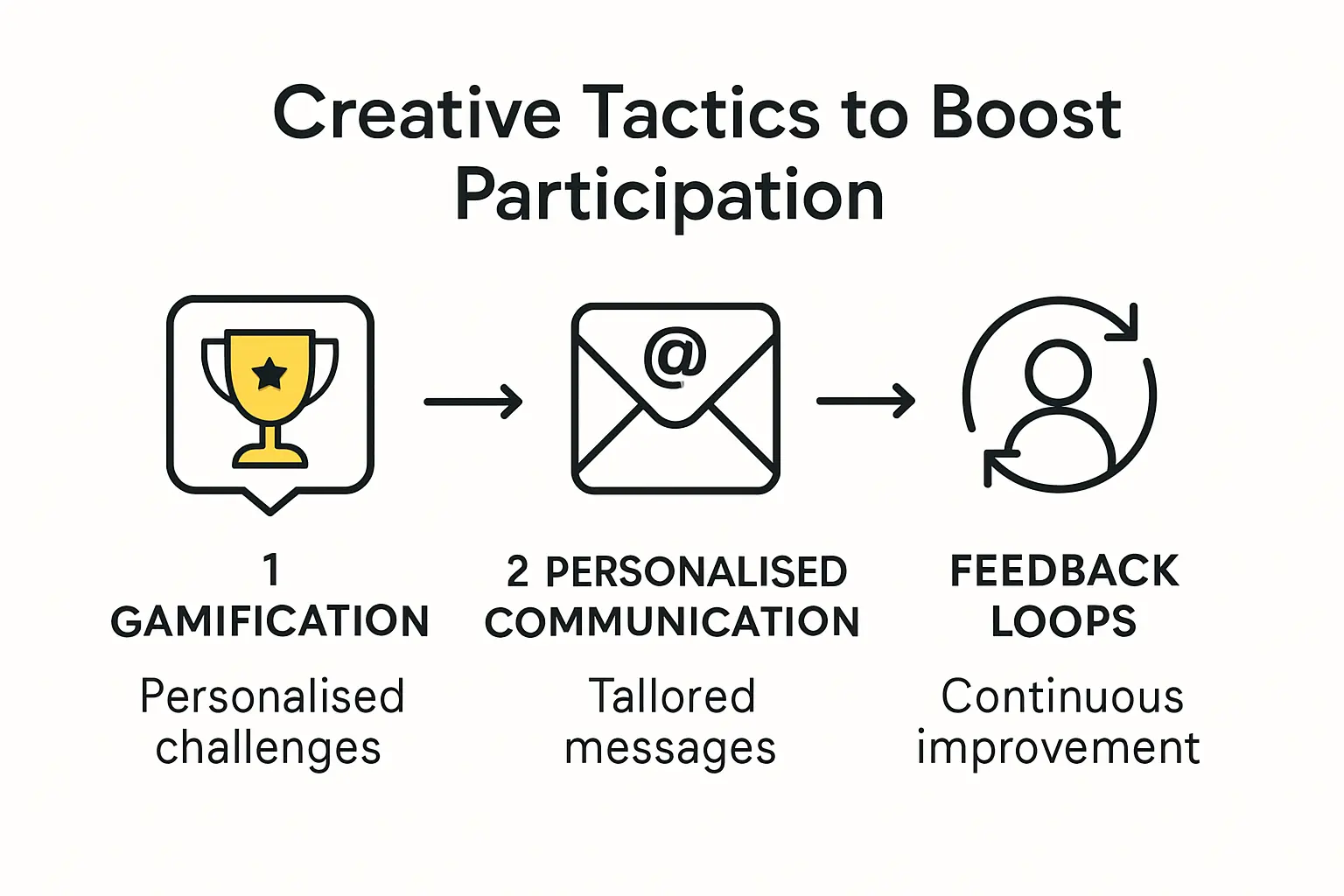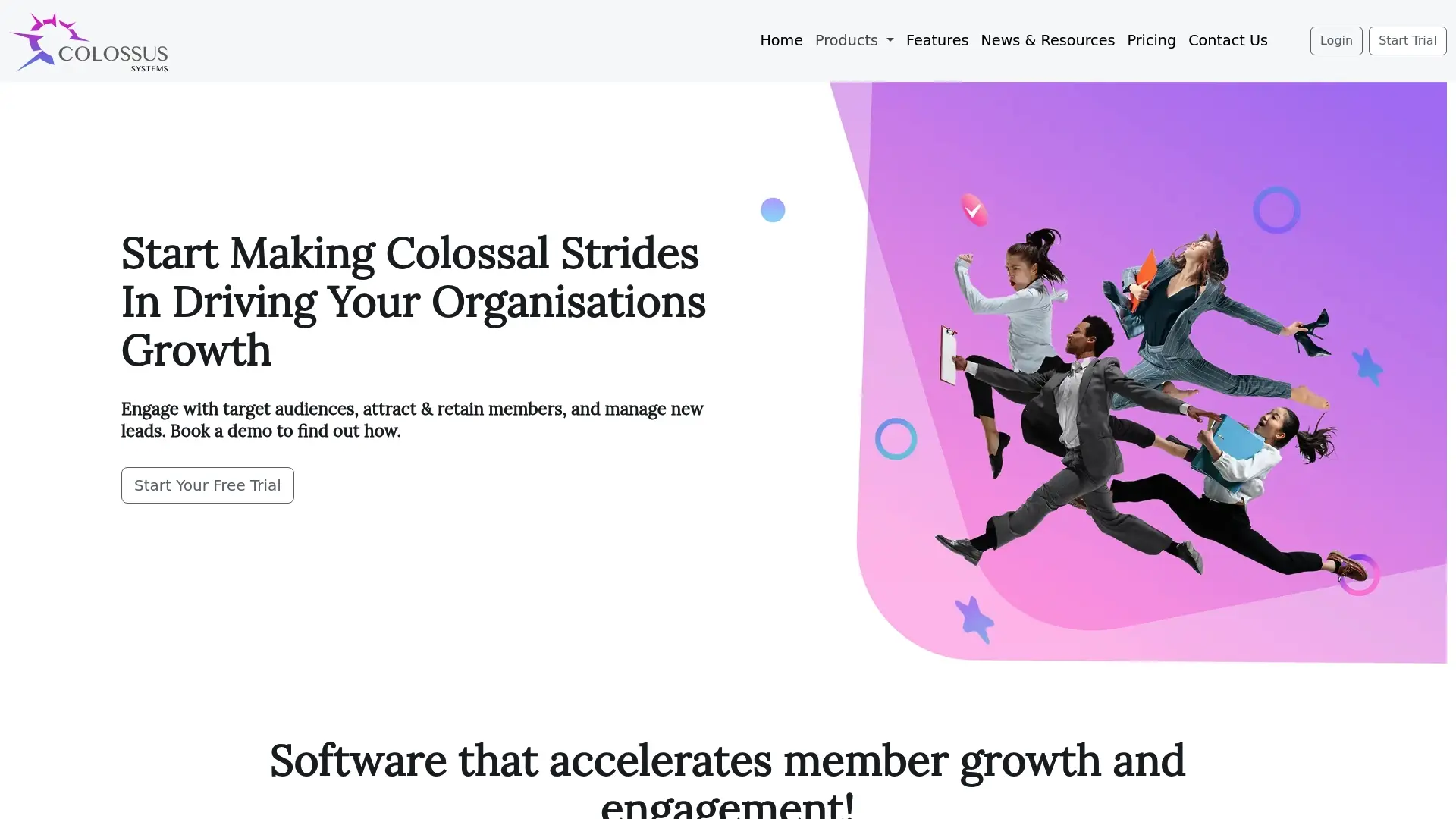Improving Member Engagement: Proven Strategies for 2025

Organisations everywhere are searching for smarter ways to keep their members invested and passionate, because stronger engagement directly fuels growth and loyalty. Now, most assume basic emails or annual surveys are enough to get results. Yet studies show that when interactive gamification is introduced, participation can increase by as much as 60 percent, leaving traditional methods far behind. This fresh approach turns engagement into an ongoing, lively experience instead of a routine obligation.
Table of Contents
- Understanding The Drivers Of Member Engagement
- Creative Tactics For Boosting Participation
- Using Technology To Improve Member Engagement
- Measuring Success And Adapting Your Approach
Quick Summary
| Takeaway | Explanation |
|---|---|
| Understand psychological drivers of engagement | Recognising members’ needs for belonging, value, and contribution fosters deeper involvement. |
| Leverage technology for personalised experiences | Utilising data analytics enables tailored member interactions that cater to individual preferences and needs. |
| Implement feedback mechanisms and adapt | Regularly collecting member feedback helps refine strategies and enhance engagement continuously. |
| Gamify member participation to increase involvement | Introducing game-like elements can motivate members by making participation more enjoyable and rewarding. |
| Communicate with transparency and trust | Open and honest communication fosters trust, prompting higher levels of member engagement and participation. |
Understanding the Drivers of Member Engagement
Member engagement represents a complex ecosystem of psychological, social, and organisational factors that motivate individuals to actively participate and invest time in an organisation. Successful engagement strategies go far beyond simple communication tactics and require a nuanced understanding of human motivation and organisational dynamics.
Psychological Foundations of Member Participation
At the core of member engagement lie fundamental psychological needs that drive human behaviour. Discover effective engagement strategies that tap into these intrinsic motivations. According to a 2022 healthcare study, members are most likely to remain actively involved when their participation satisfies three critical psychological requirements: sense of belonging, perceived value, and opportunities for meaningful contribution.
People inherently seek connections that validate their identity and professional aspirations. When membership offers a platform for personal and professional growth, individuals become more emotionally invested. This means organisations must create environments that not only provide networking opportunities but also facilitate genuine intellectual and skill development.
Organisational Trust and Communication Dynamics
Trust emerges as a fundamental driver of sustained member engagement. The U.S. Government Accountability Office report emphasises that transparent communication and leadership credibility significantly influence members’ willingness to participate actively. Organisations that consistently demonstrate integrity, communicate clear objectives, and acknowledge member contributions create a robust engagement ecosystem.
Effective engagement requires a multi dimensional approach. Members want to feel heard, respected, and understand how their involvement contributes to broader organisational goals. This means developing communication strategies that are not just informative but also interactive, allowing members to provide feedback, share insights, and feel genuinely integrated into the organisation’s mission.
Recognition and Personal Value Alignment
Recognition plays a pivotal role in maintaining member motivation. Individuals are more likely to remain engaged when their efforts are acknowledged and their personal values align with the organisation’s mission. This involves creating personalised recognition programmes that go beyond generic appreciation and demonstrate a genuine understanding of individual member contributions.
Successful member engagement strategies must be dynamic, adaptable, and responsive to changing member needs. By understanding the psychological underpinnings of participation and creating environments that foster trust, personal growth, and meaningful recognition, organisations can build sustainable and vibrant membership communities.
To clarify the core drivers of member engagement, the following table summarises the key psychological and organisational elements discussed above and their impact on participation:
| Driver | Description | Impact on Engagement |
|---|---|---|
| Sense of Belonging | Establishing connections and community within the organisation | Increases emotional investment |
| Perceived Value | Demonstrating tangible and intangible benefits to membership | Boosts ongoing participation |
| Opportunities for Contribution | Allowing meaningful input and involvement in organisation activities | Creates deeper connection and ownership |
| Organisational Trust | Building credibility through transparent communication and ethical leadership | Sustains long-term engagement |
| Recognition and Value Alignment | Personalised acknowledgement and matching of individual values to organisational mission | Maintains motivation and loyalty |
Creative Tactics for Boosting Participation

Member participation requires innovative strategies that go beyond traditional engagement methods. Modern organisations must think creatively to capture and maintain member interest in an increasingly competitive and digitally saturated environment.
Gamification and Interactive Experiences
Gamification has emerged as a powerful technique for enhancing member participation. According to research in educational technology, interactive platforms that incorporate game-like elements can significantly boost motivation and engagement. Learn more about engagement techniques that transform passive membership into active involvement.
Successful gamification strategies include implementing point systems, achievement badges, leaderboards, and challenges that provide tangible recognition for member contributions. These approaches tap into fundamental psychological motivators like competition, achievement, and social validation. By creating structured yet enjoyable participation frameworks, organisations can transform mundane interactions into exciting opportunities for personal and professional growth.
Personalised Communication and Micro-Experiences
Personalisation represents a critical component of modern engagement tactics. A study exploring gamification impacts highlights that members respond most positively to experiences tailored to their individual interests and professional objectives. This means moving beyond generic communications to develop targeted, contextually relevant interactions.
Organisations can achieve this by leveraging data analytics to segment members, creating customised content pathways, and developing micro-experiences that align with specific member profiles. These might include curated webinars, targeted networking opportunities, or specialised skill development resources that speak directly to individual member needs and aspirations.
Dynamic Feedback and Continuous Improvement
Engagement is a two-way conversation. Successful organisations create robust feedback mechanisms that allow members to shape their experience actively. This involves implementing regular surveys, creating open communication channels, and demonstrating a genuine commitment to incorporating member insights into organisational strategy.
The key is to make members feel genuinely heard and valued. By treating feedback as a collaborative process rather than a perfunctory exercise, organisations can build trust, demonstrate responsiveness, and create a sense of shared ownership. Members who feel their opinions matter are more likely to remain actively engaged and invested in the organisation’s success.
Ultimately, boosting participation requires a holistic, dynamic approach that recognises members as active contributors rather than passive recipients. By combining technological innovation, personalised experiences, and genuine collaborative spirit, organisations can create vibrant, engaged membership communities that continue to grow and evolve.
Using Technology to Improve Member Engagement
Technology has fundamentally transformed how organisations interact with and engage their members. Modern digital platforms offer unprecedented opportunities to create more personalised, responsive, and dynamic membership experiences that transcend traditional communication methods.
Advanced Data Analytics and Personalisation
Explore our advanced engagement solutions that leverage cutting-edge technological capabilities. According to a 2023 systematic review of digital engagement strategies, organisations that effectively utilise data analytics can significantly enhance member interaction and satisfaction.
Data-driven technologies enable organisations to create highly targeted experiences by analysing member behaviour, preferences, and interaction patterns. Machine learning algorithms can predict member interests, recommend personalised content, and identify potential engagement opportunities. This approach transforms generic interactions into tailored experiences that feel individually crafted for each member.
Interactive Digital Platforms and Communication Tools
Interactive digital platforms have revolutionised member engagement by providing multiple channels of communication and participation. These technologies facilitate real-time interactions, virtual networking, and seamless information sharing. Push notifications, AI-powered chatbots, and integrated communication systems allow members to connect, learn, and contribute more effectively.
Webinars, virtual conferences, and online learning modules powered by sophisticated technology can recreate the networking and educational experiences traditionally limited by physical constraints. These digital environments offer flexibility, accessibility, and opportunities for global collaboration that were previously unimaginable.
Feedback Mechanisms and Continuous Improvement
Technology provides sophisticated tools for capturing and analysing member feedback. Advanced survey platforms, sentiment analysis tools, and real-time feedback mechanisms enable organisations to understand member experiences with unprecedented depth and accuracy.
By implementing adaptive technologies that continuously collect and interpret member input, organisations can rapidly iterate their engagement strategies. This approach creates a dynamic, responsive ecosystem where member needs are constantly understood and addressed. The result is a more agile, member-centric approach to organisational management that prioritises genuine connection and value creation.
The future of member engagement lies in embracing technological innovation that prioritises human connection. By combining advanced data analytics, interactive platforms, and responsive feedback systems, organisations can create more meaningful, personalised, and impactful membership experiences that adapt to evolving member expectations.
The table below outlines key technological solutions discussed, their purpose, and sample benefits for member engagement:
| Technological Solution | Purpose | Sample Benefits for Engagement |
|---|---|---|
| Data Analytics & AI | Analyse member behaviour and preferences | Tailored experiences, predictive recommendations |
| Interactive Digital Platforms | Enable real-time participation and networking | Flexible access, enhanced connection, global reach |
| Advanced Survey Tools | Capture structured and unstructured member feedback | Deeper insight, continuous improvement |
| AI-powered Communication | Provide instant interaction and information | Immediate responses, 24/7 support |
Measuring Success and Adapting Your Approach
Measuring member engagement is not a static process but a dynamic, continuous journey of understanding and improvement. Organisations must develop robust frameworks that provide meaningful insights into their engagement strategies and enable responsive adaptations.
Defining Clear Engagement Metrics
Explore our comprehensive engagement tracking solutions that help organisations measure success effectively. According to the Scottish Government’s Participation Handbook, defining clear purposes and scopes for engagement activities is crucial for understanding their true impact.
Key performance indicators for member engagement should encompass multiple dimensions. These include quantitative metrics like participation rates, event attendance, content interaction, and platform usage. However, equally important are qualitative measures such as member satisfaction scores, feedback quality, and perceived value of organisational offerings. By combining these metrics, organisations can develop a holistic view of their engagement effectiveness.
Implementing Adaptive Feedback Mechanisms
The Society for Human Resource Management emphasises the importance of regular performance reviews and diverse feedback channels. Modern engagement strategies require continuous, multi-channel feedback collection that goes beyond traditional annual surveys.
Effective feedback mechanisms might include real-time digital surveys, interactive feedback platforms, focus group discussions, and personalised follow-up interviews. These approaches allow organisations to capture nuanced insights into member experiences, preferences, and potential areas of improvement. Advanced analytics can transform this feedback into actionable intelligence, enabling rapid strategic adjustments.
Strategic Iteration and Continuous Learning
Gallup’s research highlights the importance of structured coaching conversations and performance reviews in maintaining engagement. Successful organisations view engagement measurement not as a one-time assessment but as an ongoing learning process.
This approach involves creating a culture of continuous improvement where feedback is systematically analysed, insights are shared transparently, and strategic adjustments are made collaboratively. Regular cross-functional meetings, data-driven strategy sessions, and open communication channels ensure that engagement strategies remain responsive to changing member needs.

Ultimately, measuring and adapting engagement is about maintaining a dynamic, member-centric approach. By establishing comprehensive metrics, implementing sophisticated feedback mechanisms, and fostering a culture of continuous learning, organisations can create engagement strategies that are not just reactive but proactively aligned with member expectations and organisational goals.
Frequently Asked Questions
What are some effective strategies to improve member engagement?
Implementing gamification, personalised communication, and dynamic feedback mechanisms are key strategies to enhance member engagement. These approaches encourage active participation and create a more enjoyable experience for members.
How can technology enhance member engagement practices?
Technology can enhance member engagement through advanced data analytics, interactive digital platforms, and effective feedback mechanisms. These tools allow organisations to tailor experiences and improve communication with members, making engagements more relevant and impactful.
Why is recognition important in member engagement?
Recognition is crucial because it acknowledges individual contributions and aligns with members’ personal values. When members feel valued, they are more likely to stay motivated and engaged with the organisation’s mission and activities.
How can organisations measure the success of their member engagement strategies?
Organisations should define clear engagement metrics, including both quantitative and qualitative measures. This could involve tracking participation rates, member feedback quality, and satisfaction scores to gain insights into the effectiveness of engagement efforts.
Transform Member Engagement Into Real Organisational Growth
Have you noticed that traditional communication, basic emails, or occasional surveys are no longer enough to truly connect with your members? As highlighted above, modern engagement demands innovative solutions shaped by gamification, personalised experiences, and seamless digital journeys. If your organisation dreams of greater member loyalty, increased participation, and measurable value, it is time to address these challenges with proven technology.

Experience how Colossus Systems empowers you to implement interactive portals, gamified events, and smart feedback mechanisms all from one unified platform. Simplify operations, tailor content, and measure results with powerful analytics built for membership growth. Discover for yourself how our advanced member engagement tools swiftly transform engagement into lasting relationships. Take action now by exploring our comprehensive platform and see how you can create the thriving, connected community your members deserve.
Recommended
- How to Boost Member Engagement and Why use Engagement Software|CS
- [The Benefits of Integrating Job Boards into Membership Organisations